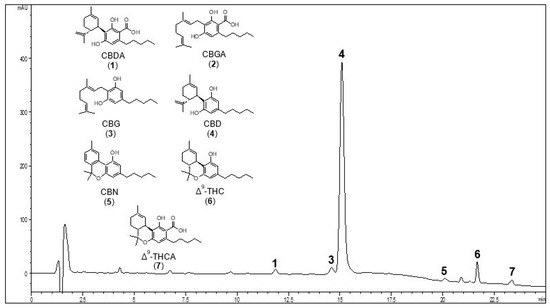
“We evaluated the effects of cannabidiol (CBD) on seizures and peroxisome proliferator-activated receptor gamma (PPARγ) levels in an animal model of temporal lobe epilepsy (TLE). Adult male Sprague-Dawley rats were continuously monitored by video-electrocorticography up to 10 weeks after an intraperitoneal kainic acid (15 mg/kg) injection. Sixty-seven days after the induction of status epilepticus and the appearance of spontaneous recurrent seizures in all rats, CBD was dissolved in medium-chain triglyceride (MCT) oil and administered subcutaneously at 120 mg/kg (n = 10) or 12 mg/kg (n = 10), twice a day for three days. Similarly, the vehicle was administered to ten epileptic rats. Brain levels of PPARγ immunoreactivity were compared to those of six healthy controls. CBD at 120 mg/kg abolished the seizures in 50% of rats (p = 0.033 vs. pre-treatment, Fisher’s exact test) and reduced total seizure duration (p < 0.05, Tukey Test) and occurrence (p < 0.05). PPARγ levels increased with CBD in the hippocampal CA1 subfield and subiculum (p < 0.05 vs. controls, Holm-Šidák test), but only the highest dose increased the immunoreactivity in the hippocampal CA3 subfield (p < 0.001), perirhinal cortex, and amygdala (p < 0.05). Overall, these results suggest that the antiseizure effects of CBD are associated with upregulation of PPARγ in the hippocampal CA3 region.”
https://pubmed.ncbi.nlm.nih.gov/35631322/
https://www.mdpi.com/1424-8247/15/5/495/htm




 “Cannabinoids reduce tremor associated with motor disorders induced by injuries and neurodegenerative disease. Here we show that this effect is mediated by cannabinoid receptors on astrocytes in the ventral horn of the spinal cord, where alternating limb movements are initiated. We first demonstrate that tremor is reduced in a mouse model of essential tremor after intrathecal injection of the cannabinoid analog WIN55,212-2. We investigate the underlying mechanism using electrophysiological recordings in spinal cord slices and show that endocannabinoids released from depolarized interneurons activate astrocytic cannabinoid receptors, causing an increase in intracellular Ca2+, subsequent release of purines and inhibition of excitatory neurotransmission. Finally, we show that the anti-tremor action of WIN55,212-2 in the spinal cords of mice is suppressed after knocking out CB1 receptors in astrocytes. Our data suggest that cannabinoids reduce tremor via their action on spinal astrocytes.”
“Cannabinoids reduce tremor associated with motor disorders induced by injuries and neurodegenerative disease. Here we show that this effect is mediated by cannabinoid receptors on astrocytes in the ventral horn of the spinal cord, where alternating limb movements are initiated. We first demonstrate that tremor is reduced in a mouse model of essential tremor after intrathecal injection of the cannabinoid analog WIN55,212-2. We investigate the underlying mechanism using electrophysiological recordings in spinal cord slices and show that endocannabinoids released from depolarized interneurons activate astrocytic cannabinoid receptors, causing an increase in intracellular Ca2+, subsequent release of purines and inhibition of excitatory neurotransmission. Finally, we show that the anti-tremor action of WIN55,212-2 in the spinal cords of mice is suppressed after knocking out CB1 receptors in astrocytes. Our data suggest that cannabinoids reduce tremor via their action on spinal astrocytes.” “The Endocannabinoid System (ECS) is primarily responsible for maintaining homeostasis, a balance in internal environment (temperature, mood, and immune system) and energy input and output in living, biological systems.
“The Endocannabinoid System (ECS) is primarily responsible for maintaining homeostasis, a balance in internal environment (temperature, mood, and immune system) and energy input and output in living, biological systems.  “Background and purpose:
“Background and purpose: 
